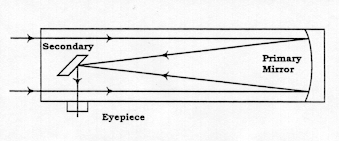Catadioptric Reflector
What the heck is a “Catadioptric Reflector?!”, you’re probably asking yourself. Well, good question! But first, we must discuss a bit about telescope construction.
There’s two main designs for telescopes, Refractors and Reflectors. Now, a Reflector is a tube design where… aah, forget it, it’s just easier to show you (BTW, I swiped these images from somewhere, so forgive me if you recognize them):
As you can see, this is what many people think of as a telescope. A long tube with a wide opening at the end for light collection, and a series of lenses for directing the light to the eyepiece.
A reflector, on the other hand, is quite different:
See, instead of using lenses to focus incoming light, this design uses a curved mirror (called the Primary mirror). The reflected light then hits the diagonal, or Secondary mirror, and is directed into the eyepiece.
Each design has their merits, though I won’t go into those here, and of course there are a number of variations on the design. Which brings us back to the original question: a Catadioptric Reflector is actually a term for a telescope which is composed of some combination of mirrors and lenses. In the case of my telescope, it’s a traditional Newtonian Reflector (as you see above), but it includes an additional lens element in the eyepiece holder itself. The effect is to increase the ‘focal length’ of the telescope, and is really just a built in Barlow Lens.

